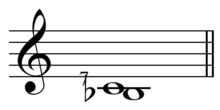Supermajor interval


In music, a supermajor interval is a musical interval that is noticeably wider than a major interval but noticeably narrower than an augmented interval. It is found in between a major and augmented interval, thus making it above, or supermajor to, the major interval.
A supermajor second is intermediate to a major second and an augmented second. An example of such an interval is the ratio 8:7, or 231.17 cents,[1] the septimal whole tone and the inverse of the subminor seventh. Another example is the ratio 15:13, or 247.74 cents.
A supermajor third is in between a major third and an augmented third. An example of such an interval is the ratio 9:7, or 435.08 cents, the septimal major third. Another example is the ratio 50:39, or 430.14 cents.
A supermajor seventh is an interval intemediate between a major seventh and an augmented seventh. It is the inverse of a subminor second. An example of such an interval is the ratio 25:13, or 1132.10 cents. Another example is the ratio 27:14, or 1132.04 cents.
Composer Lou Harrison was fascinated with the 7:6 subminor third and 8:7 supermajor second, using them in pieces such as Concerto for Piano with Javanese Gamelan, Cinna for tack-piano, and Strict Songs (for voices and orchestra).[2] Together the two produce the 4:3 just perfect fourth (a supermajor second above a subminor third is the perfect fourth).[3]
See also
Sources
- ↑ 1.0 1.1 Leta E. Miller, ed. (1988). Lou Harrison: Selected keyboard and chamber music, 1937-1994, p.xliii. ISBN 978-0-89579-414-7.
- ↑ Leta E. Miller, Fredric Lieberman (2006). Lou Harrison: American Composers, p.72. ISBN 978-0-252-03120-5.
- ↑ Miller & Lieberman (2006), p.74. "The subminor third and supermajor second combine to create a pure fourth (8⁄7 x 7⁄6 = 4⁄3)."
| ||||||||||||||||||||||||||||||||||||||||||||||||||||||||||||